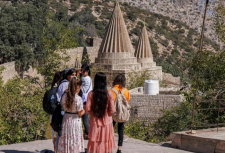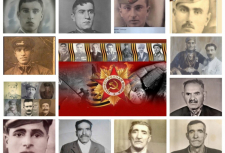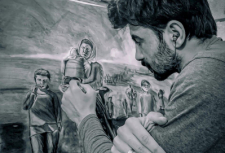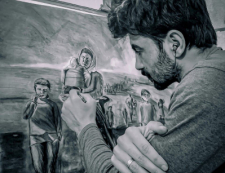Yezidism in Europe Different Generations Speak about their Religion
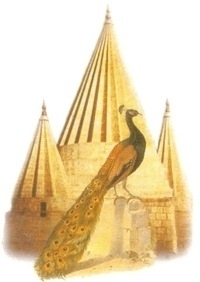
Preface
The striking difference in tone between Part I, containing interviews with Yezidis who were brought up in the homeland and mostly belong to the older generation, and Part II, which is mainly devoted to the opinions of those who were socialised in the Diaspora, obviously reflects the discrepancy between these two modes of speech: older people’s tendency to speak for the community, and the informal, personal responses of the children of the Diaspora. It is possible, of course, that the persornality of the interviewer also played a role. In order to minimise distortions of such a nature, the researchers predominantly interviewed people of similar backgrounds to their own: Dr Khalil Jindy Rashow, a middle aged, male Yezidi Sheikh from Iraq who enjoys considerable standing in the community, concentrated on the older generation; Ms Zekiye Kartal, a much younger Mirîd originally from Turkey, on the ‘Diaspora generation’ in Germany; and Dr Khanna Omarkhali, a Pir from Armenia and Russia in her mid-twenties, on Yezidis in the former Soviet Union.
As the work aims to study community discourse on various topics related to Yezidism, rather than individuals’ personal experiences of religion, selections from the interviews are arranged by topic. Although most informants stated they did not object to being named, it was felt that such a procedure, which might have unforeseen consequences in the future, was inappropriate, and speakers are indicated by their country of origin, gender, caste and age. The first letter indicates the country of origin: A = Armenia; G = Georgia; I = Iraq; S = Syria; T = Turkey. The next letter 1 See further below, p. 117.14 Preface refers to the speaker’s gender (M = male; F = female). The third letter denotes the informant’s caste or social group (S = Sheikh; Pi = Pir; Pism = Pismîr; Mi = Mirîd). AFPi28 thus stands for a 28-year-old female Pir from Armenia).
The author is very much indebted to the Deutsche For schungs Gemeinschaft for funding the research project and allowing us to continue beyond the period that was originally foreseen. Special thanks are due to my three collaborators, Dr Khalil Jindy Rashow, Ms Zekiye Kartal, and Dr Khanna Omarkhali. Without their enormous commitment to the project, this book could not have been written. Professor Preface 15Christine Allison, Professor Andreas Ackermann and Dr Sarah Stewart kindly read several Chapters and offered valuable suggestions and much-needed encouragement. Dr Ilhan Kizilhan’s contribution to our understanding of Yezidi society has been invaluable.
By Philip G. Kreyenbroek in collaboration with Z. Kartal, Kh. Omarkhali, and Kh. Jindy Rashow
Tags: #yazidisinfo #newsyazidi #aboutyazidi #ezidi #bookaboutyazidis
Yezidism in Europe Different Generations Speak about their Religion

Preface
The striking difference in tone between Part I, containing interviews with Yezidis who were brought up in the homeland and mostly belong to the older generation, and Part II, which is mainly devoted to the opinions of those who were socialised in the Diaspora, obviously reflects the discrepancy between these two modes of speech: older people’s tendency to speak for the community, and the informal, personal responses of the children of the Diaspora. It is possible, of course, that the persornality of the interviewer also played a role. In order to minimise distortions of such a nature, the researchers predominantly interviewed people of similar backgrounds to their own: Dr Khalil Jindy Rashow, a middle aged, male Yezidi Sheikh from Iraq who enjoys considerable standing in the community, concentrated on the older generation; Ms Zekiye Kartal, a much younger Mirîd originally from Turkey, on the ‘Diaspora generation’ in Germany; and Dr Khanna Omarkhali, a Pir from Armenia and Russia in her mid-twenties, on Yezidis in the former Soviet Union.
As the work aims to study community discourse on various topics related to Yezidism, rather than individuals’ personal experiences of religion, selections from the interviews are arranged by topic. Although most informants stated they did not object to being named, it was felt that such a procedure, which might have unforeseen consequences in the future, was inappropriate, and speakers are indicated by their country of origin, gender, caste and age. The first letter indicates the country of origin: A = Armenia; G = Georgia; I = Iraq; S = Syria; T = Turkey. The next letter 1 See further below, p. 117.14 Preface refers to the speaker’s gender (M = male; F = female). The third letter denotes the informant’s caste or social group (S = Sheikh; Pi = Pir; Pism = Pismîr; Mi = Mirîd). AFPi28 thus stands for a 28-year-old female Pir from Armenia).
The author is very much indebted to the Deutsche For schungs Gemeinschaft for funding the research project and allowing us to continue beyond the period that was originally foreseen. Special thanks are due to my three collaborators, Dr Khalil Jindy Rashow, Ms Zekiye Kartal, and Dr Khanna Omarkhali. Without their enormous commitment to the project, this book could not have been written. Professor Preface 15Christine Allison, Professor Andreas Ackermann and Dr Sarah Stewart kindly read several Chapters and offered valuable suggestions and much-needed encouragement. Dr Ilhan Kizilhan’s contribution to our understanding of Yezidi society has been invaluable.
By Philip G. Kreyenbroek in collaboration with Z. Kartal, Kh. Omarkhali, and Kh. Jindy Rashow
Tags: #yazidisinfo #newsyazidi #aboutyazidi #ezidi #bookaboutyazidis




